DOI:
10.1039/C5RA05287D
(Paper)
RSC Adv., 2015,
5, 37574-37580
A D–π–A–π–A type dye for highly efficient dye-sensitized solar cells†
Received
25th March 2015
, Accepted 16th April 2015
First published on 16th April 2015
Abstract
We synthesized a D–π–A–π–A type dye and demonstrated its application in dye-sensitized solar cells (DSSCs). This D–π–A–π–A type dye, named C321, consisted of a triphenylamine as a donor, a 3,4-ethylenedioxythiophene (EDOT) as a π-bridge, and a benzothiazole (BTDA)–phenyl-cyanoacrylic acid as an A–π–A group. Compared with DSSCs based on a traditional D–π–A type dye C311, the DSSCs based on C321 exhibited a significant enhancement of cell performance. A power conversion efficiency of 8.2% was achieved for DSSCs based on C321, which was 9 times higher than that for DSSCs based on C311 (0.9%). The theoretical calculations and electrochemical impedance spectroscopy investigations revealed the mechanism of the enhancement of cell performance.
1. Introduction
Dye sensitized solar cells (DSSCs) are regarded as promising devices for high-efficiency and low-cost solar energy conversion, since O'Regan and Grätzel reported the first DSSC in 1991.1–4 Small cells have recently been achieved with an efficiency of over 13.0%1–5 and a lifetime of more than 1000 hours.6 The further development of DSSCs relies on the discovery of new dyes that provide better photovoltaic properties. Explorations of new dyes for DSSCs can be divided into two categories: (1) metal complex dyes with transition metal such as N3,7,8 black dye,9–11 YD2-o-C8 (ref. 12) and SM315;5 (2) metal-free organic dyes such as C218,13,14 C219 (ref. 15) and D5.16,17 Comparing with the metal complex dyes, the metal-free organic dyes are much easier to tune their absorption spectral and electrochemical properties through tailoring molecules.18
Generally, metal-free organic dyes are consisted of a donor-π-acceptor (D–π–A) type structure, of which D is an electron-donating unit, A is an electron-accepting unit and π is a π-conjugated spacer unit. The D–π–A dye structure can induce intramolecular charge transfer (ICT) from donor to acceptor group which facilitates the high molar extinction coefficient and redshift the absorption of dye molecules. By changing donor, acceptor or π-spacer groups, the energy levels of the highest occupied molecular orbital (HOMO) and the lowest unoccupied molecular orbital (LUMO) can be shifted, resulting in various physical and chemical properties of dye molecules.19 The most common D–π–A type dyes were consisted of a triphenylamine group as donor, a cyanoacetic acid group as acceptor, and a thiophene (T) and its derivatives as π-spacer.15,20–26 For example, the cell based on dye C219 exhibited a power conversion efficiency (PCE) – 10.3%, which has been near the created by ruthenium(II) complex dyes.15 To improve the PCE of metal-free organic dyes, a strategy is to introduce an electron-accepting unit into the π-spacer group which can be named as a D–π–A–A type structure.23,27–29 For example, the introduction of benzothiadiazole (BTDA) unit, an acceptor group, into the π-spacer group can reduce the gap between HOMO and LUMO significantly, which results in an improved PCE. However, some D–π–A–A type dyes may not be efficient since the electron recombination between adjacent acceptor groups and TiO2 substrate can be intensified.30
Here, we proposed a D–π–A–π–A type dye by introducing a π group into a D–π–A–A type dye for DSSCs. As an example, we synthesized a dye C321 consisted of a triphenylamine as a donor, a 3,4-ethylenedioxythiophene (EDOT) as a π-bridge, and a benzothiazole (BTDA)–phenyl-cyanoacrylic acid as a A–π–A group, as shown in Scheme 1. The PCE of DSSCs based on C321 can reach as high as 8.3%, which is 9 times higher than that of DSSCs based on a traditional D–π–A type dye C311. Both theoretical and experimental results indicated that the enhancement of PCE may origin from the improvement of the recombination process in DSSCs.
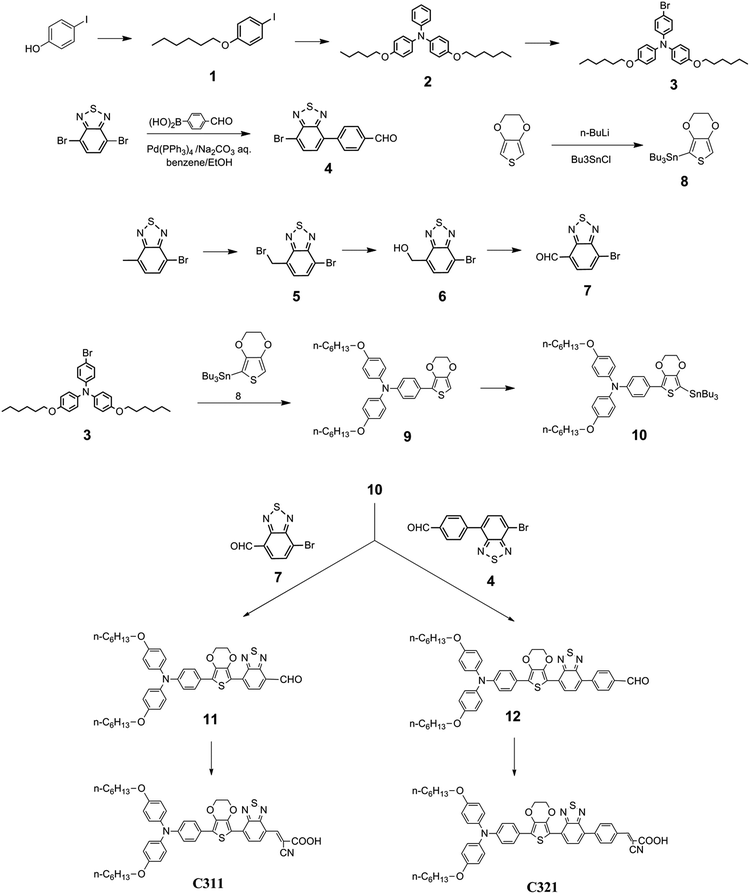 |
| | Scheme 1 Synthesis of dyes C311 and C321. | |
2. Results and discussion
2.1. Synthesis
Compound 4 (4-bromo-7-(4-formylphenyl)-2,1,3-benzothiadiazole) was synthesized via a Suzuki–Miyaura coupling reaction. Compounds 9, 11 and 12 were synthesized via still coupling reactions. The synthetic routes of C311 and C321 are shown in Scheme 1 and the detailed synthesis procedures of 1 to 12 are described in the ESI.†
2.2. Theoretical calculations
The electronic configurations of the isolated dyes were examined by using B3LYP33/6-311G** hybrid functional implanted in a Gaussian09 software.35 For calculating the absorption spectrum in CH3CN solution, a time-dependent density functional theoretical (TDDFT) with the MPW1K34 functional was employed. The optimized geometries of the two dyes, as shown in Fig. 1, have planar structures in the ground state. The calculated electron-density diagrams of HOMOs and LUMOs were shown in Fig. 1 as well. In both dyes, the HOMOs and LUMOs exhibit π-character. While the HOMO is mainly localized over the donor groups, the LUMO is localized on the accepter and π-spacer groups. The localizations of molecular orbitals are expected to have an intramolecular charge separation upon excitation. The calculated dipole-allowed absorptions were listed in Table 1. The strong absorption peaks for each dye arise from S0 → S1, which correspond to the promotion of an electron from the HOMO to LUMO. Therefore, the lowest-lying absorption transitions were all assigned to π → π* type transitions from donor to acceptor moieties through a π-spacer. Comparing with C321, C311 exhibited a maximum absorption at longer wavelength 610 nm and similar oscillator strength of absorption peak, which probably results in the greater overlap between its absorption spectrum and the solar spectrum. For these two dyes, the wavelengths of maximum absorption peaks decreased with the additional phenyl group about 50 nm. Just based on the calculated absorption spectral, the D–π–A–π–A type dye C321 should have a weaker light adsorption than the D–π–A type dye C311.
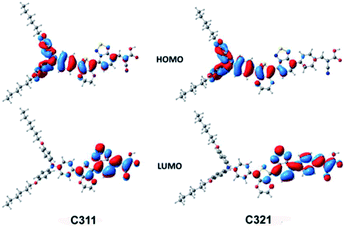 |
| | Fig. 1 HOMO and LUMO electron density distributions for frontier orbitals of dyes C311 and C321. | |
Table 1 The calculated dipole-allowed lowest lying transition for C311 and C321 under the TD-MPW1K
| |
Transition |
Wavelength (nm) |
Oscillator strength |
Major contributions |
| C311 |
S0 → S1 |
610 |
1.3452 |
HOMO → LUMO (88%) |
| C321 |
S0 → S1 |
553 |
1.3824 |
HOMO → LUMO (78%) |
The electronic coupling strength governing the photoinduced electron transfer is probably determined by the interaction between the LUMO orbital of dye and the conduction band of TiO2. To investigate this interaction, a detailed investigation of the partial density of state (PDOS) of the adsorbate's LUMO has been made. The dye-absorbed geometries were optimized in the gas phase using the Dmol3 package and the electronic structure of the combined system was subsequently calculated at B3LYP/SVP level using the Gaussian09 software. The injection times for C311 and C321 are 17 and 12 fs, respectively. The electron injection efficiency is calculated by: ηinj = 1 − τinj/τlifetime. For organic dyes, the injection process is in competition with singlet state decay to ground (singlet excited state lifetime ranging from ∼100 ps to a few nanoseconds), requiring τinj < 10 ps to achieve an injection efficiency of 90% or even more. If the excited state lifetime is set to 1 ps for C311 and C321, their ηinj equal to 98% and 99%, respectively. The calculated injection times indicated these dyes exhibit strong electronic coupling with TiO2 cluster and great quantum yield for electron injection. The calculated injection efficiencies for all dyes were very close to 100%. It indicates that the introduction of BTDA, electron-accepting unit, close to cyanoacetic acid group will not affect the electron injection process from dye to TiO2 substrate.
To reduce the charge recombination rate between the dye cation and the injected electron, the positive charge localized primarily on the donor group should be farther away from the electrode surface. Based on nonadiabatic electron-transfer theory, the recombination rate can be analyzed in terms of the Marcus formula, where HAB2 is the electronic coupling between the donor and acceptor groups, ΔG0 is the reaction free energy, and λ is the reorganization energy. The term HAB2 can be represented in terms of an exponential function of the spatial separation r between the donor and acceptor groups.31,32 According to the work by Clifford et al.,31 ΔG0 is approximately equal to λ in the recombination dynamics, and r is the primary factor affecting the recombination rate. Here, r is approximated by using the HOMO barycenter (rHOMO) of the neutral dye. Based on the geometries of dye–TiO2 complexes, the values of rHOMO of the isolated dye molecule on TiO2 substrate were evaluated as 1.69 and 2.15 nm for C311 and C321, respectively. The spatial separation between HOMO and TiO2 substrate increased obviously after the phenyl group was introduced. It indicates that the phenyl group can suppress the electron recombination between dye and TiO2 significantly, which may result in an enhancement of the photocurrent of DSSCs based on C321.
| |
 | (1) |
Based on the quantum chemical calculations, we studied the optical properties, electron injection time and electron recombination for C311 and C321. The results showed that although C311 has a promising absorption spectral performance, C321 exhibits a weak electron recombination process that may lead to a high photocurrent.
2.3. Spectroscopic properties
The UV-vis absorption spectra of C311 and C321 measured in dilute chlorobenzene solution were shown in Fig. 2, exhibiting two absorption bands over a range of 350–800 nm. The bands at 378 nm of C311 and 364 nm of C321 corresponded to the π–π* transition of the conjugated system. The longest wavelength absorption peak of C321 (λmax = 511 nm) was assigned to a charge-transfer (CT) transition. The CT band of C311 (λmax = 563 nm) was significantly red-shifted compared to that of C321. Our calculation results showed that the longest wavelength absorption peaks of C311 and C321 were 610 and 553 nm, respectively, which were in good agreement with the experimental values. The molar extinction coefficient for the CT transition of C311 and C321 were 4.11 × 104 and 4.35 × 104 M−1 cm−1, respectively, which are much higher than that of the well-known dye N719 (<2 × 104 M−1 cm−1). The UV-vis spectra of C311 and C321 adsorbed onto 2 μm transparent TiO2 films (Fig. 2b) showed a significant red-shift of the CT-band for C321 (λmax shifted from 511 nm to 531 nm) and a slight red-shift for C311 (λmax shifted from 563 to 566 nm) compared to their spectra in solution. All data were listed in Table 2.
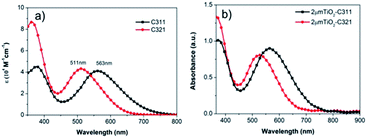 |
| | Fig. 2 (a) UV-vis spectra of dyes C311 and C321 in chlorobenzene. (b) UV-vis spectra of dyes C311 and C321 on transparent TiO2 films (2 μm). | |
Table 2 Calculated and experimental parameters for dyes C311 and C321
| Dye |
λmax,exp (nm) |
εmax,exp (M−1 cm−1) |
Eox (V) |
Ered (V) |
HOMOexp (eV) |
LUMOexp (eV) |
HOMOcal (eV) |
LUMOcal (eV) |
Eoptg (eV) |
Ecalg (eV) |
| C311 |
563 |
4.11 × 104 |
0.7 |
−0.95 |
−4.89 |
−3.24 |
−4.95 |
−3.12 |
1.65 |
1.83 |
| C321 |
511 |
4.35 × 104 |
0.65 |
−1.2 |
−4.84 |
−2.99 |
−4.82 |
−2.94 |
1.85 |
1.92 |
2.4. Electrochemical properties
To evaluate the energetics of C311 and C321, cyclic voltammograms (CV) was performed to measure the oxidation potentials (Eox), which correspond to the HOMO level potentials of the sensitizers. The oxidation potentials of the dyes were measured in dichloromethane containing 0.1 M tetrabutylammonium hexafluorophosphate (TBAHFP) as electrolyte, ferrocene/ferrocenium (Fc/Fc+) as an internal reference (Fig. 3). The results were summarized in Table 2, the half-wave potentials of C311 and C321 were 0.5 and 0.45 V, respectively. The HOMO levels of C311 and C321 can be determined as −4.89 eV and −4.84 eV vs. vacuum, respectively. The LUMO level can be estimated from the values of oxidation potential and the zero-to-zero transition energy measured at the intersection of absorption spectra. We estimated that the LUMO energy levels of C311 and C321 were −3.24 eV and −2.99 eV, respectively, which lie above the conduction band edge of TiO2 (approximately −4.0 eV vs. vacuum). This result indicated that the driving force is sufficient for electron injecting from the dyes into the conduction band of TiO2. The energies of HOMO and LUMO of the dyes were in good agreement with the calculation results (list in Table 2).
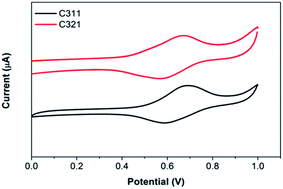 |
| | Fig. 3 CV spectra of C311 and C321 in dichloromethane (CH2Cl2) solution (5 × 10−4 M) containing 0.1 M TBAHFP. | |
2.5. Application in DSSCs
The current–voltage (J–V) characteristics of DSSCs based on C311 and C321 on 6 μm thick TiO2 films (with 5 μm scattering) employing a I−/I3− electrolyte were measured under one sun solar illumination conditions (AM 1.5G, 100 mW cm−2), as shown in Fig. 4. The electrolyte solution was consisted of 1.0 M 1,3-dimethylimidazolium iodide, 0.05 M lithium iodide (LiI), 0.03 M iodine, 0.5 M tert-butylpyridine and 0.1 M guanidinium thiocyanate in an 85![[thin space (1/6-em)]](https://www.rsc.org/images/entities/char_2009.gif) :
:![[thin space (1/6-em)]](https://www.rsc.org/images/entities/char_2009.gif) 15 (v/v) acetonitrile/valeronitrile mixture (E1). The photovoltaic parameters of DSSCs including short-circuit photocurrent density (Jsc), open-circuit photovoltage (Voc), fill factor (FF), and solar-to-electric power conversion efficiencies (η) were summarized in Table 3. The DSSCs based on C321 provided an overall solar-to-electric power conversion efficiency of 8.2% with a high short-circuit photocurrent density 16.78 mA cm−2 and a high open-circuit photovoltage 686 mV (FF = 71.1%). Under the same conditions, the cells based on C311 showed a poor performance with an overall η of 0.9% due to low Jsc and Voc values (Jsc = 2.32 mA cm−2, Voc = 572 mV, FF = 70.6%). The incident photon-to-current conversion efficiency (IPCE) spectra of DSSCs based on C321 and C311 were much different, as shown in Fig. 5. The IPCE of cells based on C321 exhibited 89% at 560 nm, while cells based on C311 show only 14% at 540 nm. The photovoltaic performances of DSSCs have been optimized by using different TiO2 film thickness (Fig. S1,† Table 4). A TiO2 layer (6 μm transparent +5 μm scattering) showed the best photocurrent density and solar-to-electric power conversion efficiencies.
15 (v/v) acetonitrile/valeronitrile mixture (E1). The photovoltaic parameters of DSSCs including short-circuit photocurrent density (Jsc), open-circuit photovoltage (Voc), fill factor (FF), and solar-to-electric power conversion efficiencies (η) were summarized in Table 3. The DSSCs based on C321 provided an overall solar-to-electric power conversion efficiency of 8.2% with a high short-circuit photocurrent density 16.78 mA cm−2 and a high open-circuit photovoltage 686 mV (FF = 71.1%). Under the same conditions, the cells based on C311 showed a poor performance with an overall η of 0.9% due to low Jsc and Voc values (Jsc = 2.32 mA cm−2, Voc = 572 mV, FF = 70.6%). The incident photon-to-current conversion efficiency (IPCE) spectra of DSSCs based on C321 and C311 were much different, as shown in Fig. 5. The IPCE of cells based on C321 exhibited 89% at 560 nm, while cells based on C311 show only 14% at 540 nm. The photovoltaic performances of DSSCs have been optimized by using different TiO2 film thickness (Fig. S1,† Table 4). A TiO2 layer (6 μm transparent +5 μm scattering) showed the best photocurrent density and solar-to-electric power conversion efficiencies.
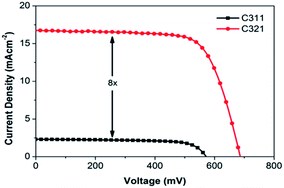 |
| | Fig. 4 J–V curves of DSSCs sensitized with C311 and C321. | |
Table 3 Photovoltaic parameters of DSSCs sensitized by C311 and C321
| Dye |
Jsc (mA cm−2) |
Voc (mV) |
FF (%) |
η (%) |
| C311 |
2.32 |
572 |
70.6 |
0.9 |
| C321 |
16.78 |
686 |
71.1 |
8.2 |
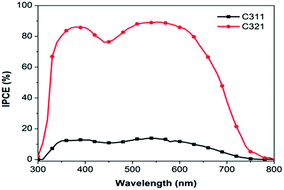 |
| | Fig. 5 IPCE spectra for DSSCs sensitized with C311 and C321. | |
Table 4 Photovoltaic parameters of DSSCs sensitized by C321 dye absorbed on TiO2 films of different thicknesses
| Entry |
TiO2 film thickness (μm) |
Jsc (mA cm−2) |
Voc (mV) |
FF (%) |
η (%) |
| 1 |
4 + 5 |
12.91 |
678 |
71.7 |
6.3 |
| 2 |
6 + 5 |
16.44 |
688 |
71.2 |
8.1 |
| 3 |
8 + 5 |
14.46 |
684 |
74.2 |
7.3 |
The difference between C311 and C321 is only a π-conjugated spacer unit (phenyl ring) between the benzothiadiazole unit and the anchoring group. However, this small modification changed the D–π–A type dye C311 as the D–π–A–π–A type dye C321, which results in a significant enhancement of the photovoltaic performances. In order to explain this phenomenon, the electrochemical impedance spectroscopy (EIS) of as-prepared DSSCs based on C311 and C321 were measured. Fig. 6 shows the Nyquist and Bode plots for DSSCs based on C311 and C321. The responses in the frequency regions around 103 to 105, 10 to 102, and 0.05 to 1 Hz were contributed to charge-transfer processes occurring at the Pt electrode/electrolyte interface, the TiO2 electrode/dye/electrolyte interface, and the Nernst diffusion within the electrolyte, respectively.36 The larger semicircle in the Nyquist plots was attributed to the charge-transfer resistance (Rct) at the TiO2 electrode/dye/electrolyte interface. The Rct values can be calculated by fitting the curves using an equivalent model,37 the equivalent circuit shown in Fig. S2.† The fitted Rct of the cells sensitized by C311 and C321 are 9.7 and 42.6 Ω. It corresponds to the charge recombination rate (kr) at the TiO2/dye/electrolyte interface of DSSCs. Through the recombination rate and Rct equation,38 where A is the cell area, T is the temperature, kB is Boltzmann's constant, L is the thickness of the film, q is elementary charge and nc is the density of electrons in the conduction band, the charge-transfer resistance is inversely proportional to the recombination rate.
| |
 | (2) |
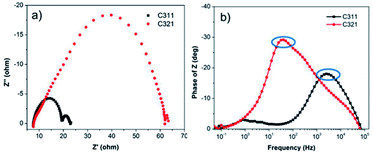 |
| | Fig. 6 (a) Nyquist and (b) Bode phase plots of dye-sensitized solar cells sensitized by C311 and C321 dyes. The cells were measured at 0.7 V bias voltage in the dark. | |
The nc values can be calculated by the by fitting the curves of Nyquist phase (eqn (S1)†). The nc values of the cells sensitized by C311 and C321 are 3.72 × 1017 and 1.28 × 1019 cm−3, respectively. Through the above equation, the kr of DSSCs sensitized by C311 and C321 are 142.6 and 4.2 s−1. The recombination rate of C311 is 34 times higher than that of C321, demonstrating that the charge recombination of the device sensitized by C321 is efficiently suppressed, leading to the improvement of the photocurrent and photovoltaic. The electron lifetime (tn) can be estimated according to the equation: tn = 1/(2πfmax), where fmax is the maximum frequency of the mid-frequency peak.39 The fmax values were determined as 2511 and 39.8 Hz for the DSSCs based on C311 and C321, respectively. Correspondingly, the calculated electron lifetimes were 0.13 and 4.0 ms for the DSSCs based on C311 and C321. This result suggests that the tn of the DSSCs based on C321 exhibited a 123 times higher than that of DSSCs based on C311, leading to the improvement of the photocurrent. This experimental result was in consistent with the calculation result that C321 has a much weaker recombination process than C311. The EIS results explained the significant enhancement of cell performance by replacing a D–π–A type dye (C311) with a D–π–A–π–A type dye (C321).
3. Conclusion
In summary, we report a new D–π–A–π–A type dye C321. Due to the introduction of a π-conjugated spacer unit (phenyl ring) between the benzothiadiazole (BTDA) unit and the anchoring group, C321 exhibited a great enhancement on the photovoltaic performance compared with the traditional D–π–A type dye C311. The cell efficiency of DSSCs based on C321 can reach as high as 8.2%, which was superior to that of DSSCs based on C311 (0.9%) under one sun illumination. The EIS results revealed that C321 has a higher charge-transfer resistance (Rct) and a higher electron lifetime than C311 in DSSCs, which was in consistent with the calculation results. These results suggested that the D–π–A–π–A type dye would be a novel class of dyes for efficient DSSCs.
4. Experimental section
4.1. Device fabrication
The photoelectrodes were prepared by screen-printing double layers of nanocrystalline TiO2 particles, for transparent films a 6 μm thick layer of 20 nm-sized TiO2 particles was printed on the fluorine doped tin oxide (FTO, TCO-15, 14 ohm/square, NSG, Japan) conducting glass by successive screen printing using a TiO2 paste (DSL 18-NR, Dyesol, Australia). Where applicable, a 5 μm thick scattering layer of 400 nm sized TiO2 particles (WER-2, Dyesol, Australia) was then covered on top of the transparent layer. The electrodes were dried at 150 °C for 5 min and then heated at 500 °C for 45 min, after cooling to room temperature the electrodes were soaked in a 40 mM TiCl4 aqueous solution at 70 °C for 40 min. After sintering at 500 °C for 15 min and cooling to 100 °C, the sintered electrodes were immersed into sensitizer solution (0.3 mM of the dye with 2 mM of chenodeoxycholic acid, in chlorobenzene) for 6 h, and then assembled using a thermally platinized FTO counter electrode through a 50 μm thick hot melt ring (Bynel, Dupont) by heating. The electrolyte solution was 1.0 M 1,3-dimethylimidazolium iodide, 0.05 M lithium iodide (LiI), 0.03 M iodine, 0.5 M tert-butylpyridine and 0.1 M guanidinium thiocyanate in an 85![[thin space (1/6-em)]](https://www.rsc.org/images/entities/char_2009.gif) :
:![[thin space (1/6-em)]](https://www.rsc.org/images/entities/char_2009.gif) 15 (v/v) acetonitrile/valeronitrile mixture. The electrolyte was filled in the cell's internal space by using a vacuum pump.
15 (v/v) acetonitrile/valeronitrile mixture. The electrolyte was filled in the cell's internal space by using a vacuum pump.
4.2. Device characterization
The UV-Vis absorption spectrum was recorded on a Persee TU-1810 UV-Vis spectrometer. Sun 2000 solar simulator (Abet-technologies, USA) was used to give an irradiance of 100 mW cm−2 (AM 1.5G) of the cell and light intensity was measured by using a silicon reference cell. The photocurrent density–voltage (J–V) characteristics under simulated AM 1.5G illumination were measured by using a Keithley 2400 Source meter. Incident photon-to-current conversion efficiency (IPCE) were measured by a QE/IPCE Measurement Kit (Oriel, USA, M66901), and the incident-photon flux was obtained by using a calibrated silicon reference photodiode. The devices were masked to a working area of 0.160 cm2. Electrochemical data was obtained by a Versa STAT 3 (METEK, USA) electrochemical workstation.
4.3. Synthesis of photosensitizers
All reagents were purchased from Aladdin, TCI and Alfa Aesar and used as received without further purification. The solvents were purified by distillation under a nitrogen atmosphere prior to use. 1H NMR and 13C NMR spectra were recorded on a BRUKER AVANCE 400 MHz NMR Instrument by using CDCl3 and DMSO-d6 as solvent, using tetramethylsilane as an internal reference. MALDI-TOF was performed on an AB SCIEX instrument, using CHCA as a matrix.
2-Cyano-3-{7-{4-[N,N-bis(4-hexyloxyphenyl)-4-aminophenyl]-3,4-ethylenedioxythiophene-2-yl}benzo[1,2,5]thiadiazole-4-yl}acrylic acid (C311). Compound 11 (150 mg, 0.21 mmol), ammonium acetate (16 mg, 0.21 mmol) and cyanoacetic acid (179 mg, 2.2 mmol) were dissolved in a mixture of DCM/MeCN (60 mL, 2![[thin space (1/6-em)]](https://www.rsc.org/images/entities/char_2009.gif) :
:![[thin space (1/6-em)]](https://www.rsc.org/images/entities/char_2009.gif) 1 v/v). The mixture was refluxed under argon atmosphere for 10 h. After cooling to room temperature, the reaction mixture was dissolved in dichloromethane (3 × 50 mL), washed with water (2 × 20 mL) and dried over MgSO4. The solvent was removed in vacuo. The crude product was purified by column chromatography (dichloromethane/methanol) to obtain dye C311 as a dark blue solid (111 mg, 65%). 1H NMR (400 MHz, CDCl3) δ: 9.26 (s, 1H), 8.92 (d, J = 7.6 Hz, 1H), 8.59 (d, J = 7.6 Hz, 1H), 7.69 (d, J = 8.4 Hz, 2H), 7.08 (d, J = 8.4 Hz, 4H), 6.95 (d, J = 8.4 Hz, 2H), 6.85 (d, J = 8.8 Hz, 4H), 4.52 (m, 2H), 4.42 (m, 2H), 3.96 (t, J = 6.0 Hz, 4H), 1.82 (m, 4H), 1.51 (m, 4H), 1.37 (m, 8H), 0.94 (m, 6H). 13C NMR (400 MHz, DMSO-d6) δ: 155.4, 153.9, 150.7, 147.7, 142.8, 139.8, 139.5, 137.3, 128.1, 127.2, 126.8, 126.7, 124.4, 123.8, 122.7, 121.0, 119.1, 115.5, 108.9, 67.6, 65.1, 64.2, 30.9, 28.7, 25.2, 22.0, 13.8. MALDI-TOF (m/z): 814.6 [M+].
1 v/v). The mixture was refluxed under argon atmosphere for 10 h. After cooling to room temperature, the reaction mixture was dissolved in dichloromethane (3 × 50 mL), washed with water (2 × 20 mL) and dried over MgSO4. The solvent was removed in vacuo. The crude product was purified by column chromatography (dichloromethane/methanol) to obtain dye C311 as a dark blue solid (111 mg, 65%). 1H NMR (400 MHz, CDCl3) δ: 9.26 (s, 1H), 8.92 (d, J = 7.6 Hz, 1H), 8.59 (d, J = 7.6 Hz, 1H), 7.69 (d, J = 8.4 Hz, 2H), 7.08 (d, J = 8.4 Hz, 4H), 6.95 (d, J = 8.4 Hz, 2H), 6.85 (d, J = 8.8 Hz, 4H), 4.52 (m, 2H), 4.42 (m, 2H), 3.96 (t, J = 6.0 Hz, 4H), 1.82 (m, 4H), 1.51 (m, 4H), 1.37 (m, 8H), 0.94 (m, 6H). 13C NMR (400 MHz, DMSO-d6) δ: 155.4, 153.9, 150.7, 147.7, 142.8, 139.8, 139.5, 137.3, 128.1, 127.2, 126.8, 126.7, 124.4, 123.8, 122.7, 121.0, 119.1, 115.5, 108.9, 67.6, 65.1, 64.2, 30.9, 28.7, 25.2, 22.0, 13.8. MALDI-TOF (m/z): 814.6 [M+].
3-{4-{7-{4-[N,N-Bis(4-hexyloxyphenyl)-4-aminophenyl]-3,4-ethylenedioxythiophene-2-yl}benzo[1,2,5]thiadiazole-4-yl}phenyl}-2-cyanoacrylic acid (C321). Dye C321 was synthesized by the same method as dye C311 by using compound 12 (85 mg, 0.10 mmol) instead of compound 11. Dye C321 was obtained as a dark blue solid (41 mg, 45%). 1H NMR (400 MHz, DMSO-d6) δ: 8.51 (d, J = 8.0 Hz, 1H), 8.18 (d, J = 8.4 Hz, 2H), 8.05 (m, 4H), 7.61 (d, J = 8.8 Hz, 2H), 7.03 (d, J = 8.8 Hz, 4H), 6.92 (d, J = 8.8 Hz, 4H), 6.84 (d, J = 8.8 Hz, 2H), 4.52 (m, 2H), 4.42 (m, 2H), 3.95 (t, J = 6.4 Hz, 4H), 1.74 (m, 4H), 1.45 (m, 4H), 1.33 (m, 8H), 0.90 (m, 6H). 13C NMR (400 MHz, DMSO-d6) δ: 155.8, 153.3, 152.3, 147.9, 142.4, 140.1, 137.8, 129.9, 129.7, 127.3, 127.2, 125.8, 124.6, 120.2, 119.9, 115.9, 99.9, 68.1, 31.5, 29.2, 25.7, 22.5, 14.4. MALDI-TOF (m/z): 890.7 [M +].
Acknowledgements
This work was supported by NSFC 9133316, 21403211, and “Chutian” project of China Three Gorges University. The authors thank the National Supercomputing Center in Shenzhen for providing computing resources.
References
- A. Hagfeldt, G. Boschloo, L. Sun, L. Kloo and H. Pettersson, Chem. Rev., 2010, 110, 6595–6663 CrossRef CAS PubMed.
- A. Hagfeldt and M. Graetzel, Chem. Rev., 1995, 95, 49–68 CrossRef CAS.
- B. O'Regan and M. Grätzel, Nature, 1991, 353, 737–740 CrossRef.
- M. T. Spitler and B. A. Parkinson, Acc. Chem. Res., 2009, 42, 2017–2029 CrossRef CAS PubMed.
- S. Mathew, A. Yella, P. Gao, R. Humphry-Baker, B. F. Curchod, N. Ashari-Astani, I. Tavernelli, U. Rothlisberger, M. K. Nazeeruddin and M. Gratzel, Nat. Chem., 2014, 6, 242–247 CrossRef CAS PubMed.
- D. Shi, N. Pootrakulchote, R. Li, J. Guo, Y. Wang, S. M. Zakeeruddin, M. Grätzel and P. Wang, J. Phys. Chem. C, 2008, 112, 17046–17050 CAS.
- M. Gratzel, J. Photochem. Photobiol., A, 2004, 164, 3–14 CrossRef CAS PubMed.
- M. K. Nazeeruddin, A. Kay, I. Rodicio, R. Humphrybaker, E. Muller, P. Liska, N. Vlachopoulos and M. Gratzel, J. Am. Chem. Soc., 1993, 115, 6382–6390 CrossRef CAS.
- M. K. Nazeeruddin, P. Pechy, T. Renouard, S. M. Zakeeruddin, R. Humphry-Baker, P. Comte, P. Liska, L. Cevey, E. Costa, V. Shklover, L. Spiccia, G. B. Deacon, C. A. Bignozzi and M. Gratzel, J. Am. Chem. Soc., 2001, 123, 1613–1624 CrossRef CAS PubMed.
- Y. Chiba, A. Islam, Y. Watanabe, R. Komiya, N. Koide and L. Y. Han, Jpn. J. Appl. Phys., 2006, 45, L638–L640 CrossRef CAS.
- M. K. Nazeeruddin, P. Pechy and M. Gratzel, Chem. Commun., 1997, 1705–1706 RSC.
- A. Yella, H.-W. Lee, H. N. Tsao, C. Yi, A. K. Chandiran, M. K. Nazeeruddin, E. W.-G. Diau, C.-Y. Yeh, S. M. Zakeeruddin and M. Grätzel, Science, 2011, 334, 629–634 CrossRef CAS PubMed.
- R. Li, J. Liu, N. Cai, M. Zhang and P. Wang, J. Phys. Chem. B, 2010, 114, 4461–4464 CrossRef CAS PubMed.
- M. F. Xu, D. F. Zhou, N. Cai, J. Y. Liu, R. Z. Li and P. Wang, Energy Environ. Sci., 2011, 4, 4735–4742 CAS.
- W. Zeng, Y. Cao, Y. Bai, Y. Wang, Y. Shi, M. Zhang, F. Wang, C. Pan and P. Wang, Chem. Mater., 2010, 22, 1915–1925 CrossRef CAS.
- X. Jiang, K. M. Karlsson, E. Gabrielsson, E. M. J. Johansson, M. Quintana, M. Karlsson, L. Sun, G. Boschloo and A. Hagfeldt, Adv. Funct. Mater., 2011, 21, 2944–2952 CrossRef CAS PubMed.
- D. P. Hagberg, X. Jiang, E. Gabrielsson, M. Linder, T. Marinado, T. Brinck, A. Hagfeldt and L. Sun, J. Mater. Chem., 2009, 19, 7232–7238 RSC.
- N. Robertson, Angew. Chem., Int. Ed., 2006, 45, 7321 CrossRef CAS PubMed.
- A. Mishra, M. K. Fischer and P. Bauerle, Angew. Chem., Int. Ed., 2009, 48, 2474–2499 CrossRef CAS PubMed.
- H.-H. Chou, Y.-C. Chen, H.-J. Huang, T.-H. Lee, J. T. Lin, C. Tsai and K. Chen, J. Mater. Chem., 2012, 22, 10929 RSC.
- G. Li, K. J. Jiang, Y. F. Li, S. L. Li and L. M. Yang, J. Phys. Chem. C, 2008, 112, 11591–11599 CAS.
- W. H. Liu, I. C. Wu, C. H. Lai, P. T. Chou, Y. T. Li, C. L. Chen, Y. Y. Hsu and Y. Chi, Chem. Commun., 2008, 5152–5154 RSC.
- C. J. Qin, A. Islam and L. Y. Han, J. Mater. Chem. A, 2012, 22, 19236–19243 RSC.
- R. Z. Li, X. J. Lv, D. Shi, D. F. Zhou, Y. M. Cheng, G. L. Zhang and P. Wang, J. Phys. Chem. C, 2009, 113, 7469–7479 CAS.
- J. Y. Liu, J. Zhang, M. F. Xu, D. F. Zhou, X. Y. Jing and P. Wang, Energy Environ. Sci., 2011, 4, 3021–3029 CAS.
- J. Y. Liu, D. F. Zhou, M. F. Xu, X. Y. Jing and P. Wang, Energy Environ. Sci., 2011, 4, 3545–3551 CAS.
- S. Y. Qu, C. J. Qin, A. Islam, Y. Z. Wu, W. H. Zhu, J. L. Hua, H. Tian and L. Y. Han, Chem. Commun., 2012, 48, 6972–6974 RSC.
- Y. Z. Wu, M. Marszalek, S. M. Zakeeruddin, Q. Zhang, H. Tian, M. Gratzel and W. H. Zhu, Energy Environ. Sci., 2012, 5, 8261–8272 CAS.
- W. Zhu, Y. Wu, S. Wang, W. Li, X. Li, J. Chen, Z.-s. Wang and H. Tian, Adv. Funct. Mater., 2011, 21, 756–763 CrossRef CAS PubMed.
- S. Haid, M. Marszalek, A. Mishra, M. Wielopolski, J. Teuscher, J.-E. Moser, R. Humphry-Baker, S. M. Zakeeruddin, M. Grätzel and P. Bäuerle, Adv. Funct. Mater., 2012, 22, 1291–1302 CrossRef CAS PubMed.
- J. N. Clifford, E. Palomares, M. K. Nazeeruddin, M. Grätzel, J. Nelson, X. Li, N. J. Long and J. R. Durrant, J. Am. Chem. Soc., 2004, 126, 5225–5233 CrossRef CAS PubMed.
- F. De Angelis, G. Vitillaro, L. Kavan, M. K. Nazeeruddin and M. Grätzel, J. Phys. Chem. C, 2012, 116, 18124–18131 CAS.
- A. D. Becke, J. Chem. Phys., 1993, 98, 5648–5652 CrossRef CAS PubMed.
- B. J. Lynch, P. L. Fast, M. Harris and D. G. Truhlar, J. Phys. Chem. A, 2000, 104, 4811–4815 CrossRef CAS.
- M. J. Frisch, G. W. Trucks, H. B. Schlegel, G. E. Scuseria, M. A. Robb and J. R. Cheeseman, Gaussian 09: Revision A01, 2009 Search PubMed.
- C. Longo, A. F. Nogueira, M. A. De Paoli and H. Cachet, J. Phys. Chem. B, 2002, 106, 5925–5930 CrossRef CAS.
- F. Fabregat-Santiago, J. Bisquert, G. Garcia-Belmonte, G. Boschloo and A. Hagfeldt, Sol. Energy Mater. Sol. Cells, 2005, 87, 117–131 CrossRef CAS PubMed.
- J. Bisquert, F. Fabregat-Santiago, I. Mora-Sero, G. Garcia-Belmonte and S. Gimenez, J. Phys. Chem. C, 2009, 113, 17278–17290 CAS.
- R. Kern, R. Sastrawan, J. Ferber, R. Stangl and J. Luther, Electrochim. Acta, 2002, 47, 4213–4225 CrossRef CAS.
Footnotes |
| † Electronic supplementary information (ESI) available: See DOI: 10.1039/c5ra05287d |
| ‡ These authors contributed equally to this work. |
|
| This journal is © The Royal Society of Chemistry 2015 |
Click here to see how this site uses Cookies. View our privacy policy here. 


![[thin space (1/6-em)]](https://www.rsc.org/images/entities/char_2009.gif) :
:![[thin space (1/6-em)]](https://www.rsc.org/images/entities/char_2009.gif) 15 (v/v) acetonitrile/valeronitrile mixture (E1). The photovoltaic parameters of DSSCs including short-circuit photocurrent density (Jsc), open-circuit photovoltage (Voc), fill factor (FF), and solar-to-electric power conversion efficiencies (η) were summarized in Table 3. The DSSCs based on C321 provided an overall solar-to-electric power conversion efficiency of 8.2% with a high short-circuit photocurrent density 16.78 mA cm−2 and a high open-circuit photovoltage 686 mV (FF = 71.1%). Under the same conditions, the cells based on C311 showed a poor performance with an overall η of 0.9% due to low Jsc and Voc values (Jsc = 2.32 mA cm−2, Voc = 572 mV, FF = 70.6%). The incident photon-to-current conversion efficiency (IPCE) spectra of DSSCs based on C321 and C311 were much different, as shown in Fig. 5. The IPCE of cells based on C321 exhibited 89% at 560 nm, while cells based on C311 show only 14% at 540 nm. The photovoltaic performances of DSSCs have been optimized by using different TiO2 film thickness (Fig. S1,† Table 4). A TiO2 layer (6 μm transparent +5 μm scattering) showed the best photocurrent density and solar-to-electric power conversion efficiencies.
15 (v/v) acetonitrile/valeronitrile mixture (E1). The photovoltaic parameters of DSSCs including short-circuit photocurrent density (Jsc), open-circuit photovoltage (Voc), fill factor (FF), and solar-to-electric power conversion efficiencies (η) were summarized in Table 3. The DSSCs based on C321 provided an overall solar-to-electric power conversion efficiency of 8.2% with a high short-circuit photocurrent density 16.78 mA cm−2 and a high open-circuit photovoltage 686 mV (FF = 71.1%). Under the same conditions, the cells based on C311 showed a poor performance with an overall η of 0.9% due to low Jsc and Voc values (Jsc = 2.32 mA cm−2, Voc = 572 mV, FF = 70.6%). The incident photon-to-current conversion efficiency (IPCE) spectra of DSSCs based on C321 and C311 were much different, as shown in Fig. 5. The IPCE of cells based on C321 exhibited 89% at 560 nm, while cells based on C311 show only 14% at 540 nm. The photovoltaic performances of DSSCs have been optimized by using different TiO2 film thickness (Fig. S1,† Table 4). A TiO2 layer (6 μm transparent +5 μm scattering) showed the best photocurrent density and solar-to-electric power conversion efficiencies.


![[thin space (1/6-em)]](https://www.rsc.org/images/entities/char_2009.gif) :
:![[thin space (1/6-em)]](https://www.rsc.org/images/entities/char_2009.gif) 15 (v/v) acetonitrile/valeronitrile mixture. The electrolyte was filled in the cell's internal space by using a vacuum pump.
15 (v/v) acetonitrile/valeronitrile mixture. The electrolyte was filled in the cell's internal space by using a vacuum pump.
![[thin space (1/6-em)]](https://www.rsc.org/images/entities/char_2009.gif) :
:![[thin space (1/6-em)]](https://www.rsc.org/images/entities/char_2009.gif) 1 v/v). The mixture was refluxed under argon atmosphere for 10 h. After cooling to room temperature, the reaction mixture was dissolved in dichloromethane (3 × 50 mL), washed with water (2 × 20 mL) and dried over MgSO4. The solvent was removed in vacuo. The crude product was purified by column chromatography (dichloromethane/methanol) to obtain dye C311 as a dark blue solid (111 mg, 65%). 1H NMR (400 MHz, CDCl3) δ: 9.26 (s, 1H), 8.92 (d, J = 7.6 Hz, 1H), 8.59 (d, J = 7.6 Hz, 1H), 7.69 (d, J = 8.4 Hz, 2H), 7.08 (d, J = 8.4 Hz, 4H), 6.95 (d, J = 8.4 Hz, 2H), 6.85 (d, J = 8.8 Hz, 4H), 4.52 (m, 2H), 4.42 (m, 2H), 3.96 (t, J = 6.0 Hz, 4H), 1.82 (m, 4H), 1.51 (m, 4H), 1.37 (m, 8H), 0.94 (m, 6H). 13C NMR (400 MHz, DMSO-d6) δ: 155.4, 153.9, 150.7, 147.7, 142.8, 139.8, 139.5, 137.3, 128.1, 127.2, 126.8, 126.7, 124.4, 123.8, 122.7, 121.0, 119.1, 115.5, 108.9, 67.6, 65.1, 64.2, 30.9, 28.7, 25.2, 22.0, 13.8. MALDI-TOF (m/z): 814.6 [M+].
1 v/v). The mixture was refluxed under argon atmosphere for 10 h. After cooling to room temperature, the reaction mixture was dissolved in dichloromethane (3 × 50 mL), washed with water (2 × 20 mL) and dried over MgSO4. The solvent was removed in vacuo. The crude product was purified by column chromatography (dichloromethane/methanol) to obtain dye C311 as a dark blue solid (111 mg, 65%). 1H NMR (400 MHz, CDCl3) δ: 9.26 (s, 1H), 8.92 (d, J = 7.6 Hz, 1H), 8.59 (d, J = 7.6 Hz, 1H), 7.69 (d, J = 8.4 Hz, 2H), 7.08 (d, J = 8.4 Hz, 4H), 6.95 (d, J = 8.4 Hz, 2H), 6.85 (d, J = 8.8 Hz, 4H), 4.52 (m, 2H), 4.42 (m, 2H), 3.96 (t, J = 6.0 Hz, 4H), 1.82 (m, 4H), 1.51 (m, 4H), 1.37 (m, 8H), 0.94 (m, 6H). 13C NMR (400 MHz, DMSO-d6) δ: 155.4, 153.9, 150.7, 147.7, 142.8, 139.8, 139.5, 137.3, 128.1, 127.2, 126.8, 126.7, 124.4, 123.8, 122.7, 121.0, 119.1, 115.5, 108.9, 67.6, 65.1, 64.2, 30.9, 28.7, 25.2, 22.0, 13.8. MALDI-TOF (m/z): 814.6 [M+].



